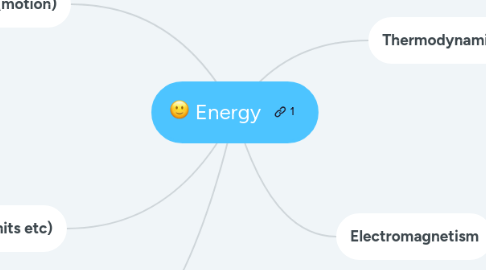Energy
作者:David Ruys


1. Kinematics (motion)
1.1. SUVAT
1.2. energy is needed to do work
1.3. mechanical energy can be categorised into kinetic energy and gravitational potential energy
1.4. Energy of motion is kinetic energy
1.4.1. Depends on mass and speed: KE = 1/2mv^2
2. General concepts (units etc)
2.1. measured in joules
2.1.1. J = kgm^2s^-2
2.2. Energy and matter are two fundamental aspects of the universe (i.e. physics)
2.2.1. Matter is just packets of energy
2.3. Can be transferred between objects
2.4. Can be converted into different forms
3. Waves and SHM
3.1. mechanical waves
3.2. Electromagnetic waves
3.3. Transverse waves
3.4. longitudinal waves
3.5. Vibrating objects (SHM) store energy
3.6. Waves transfer energy
4. Thermodynamics
4.1. 3 laws of thermodynamics
4.1.1. 1. law of conservation of energy
4.1.1.1. Thermal equilibrium
4.1.1.1.1. q=mcΔT
4.1.2. 2. entropy of universe will always increase
4.1.3. 3. 0 entropy at 0K
4.2. Thermal (heat) energy (Q) is the energy of vibration of particles
5. Electromagnetism
5.1. right hand grip rule
5.2. Only charged particles have spin
5.3. Resistance causes electron kinetic energy to convert into thermal energy due to collisions
5.4. Electric field: Region where an object in space experiences a force
5.4.1. A charged particle in a field will have Electric potential energy
